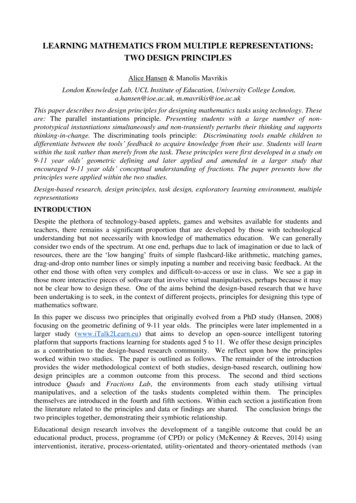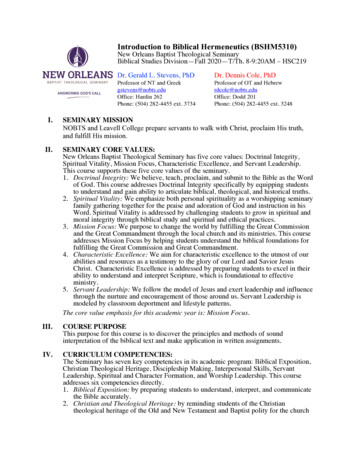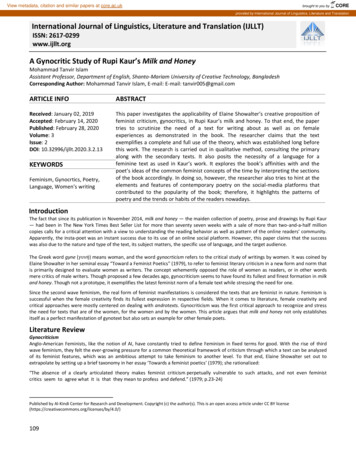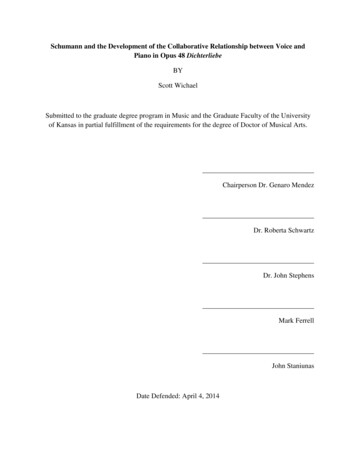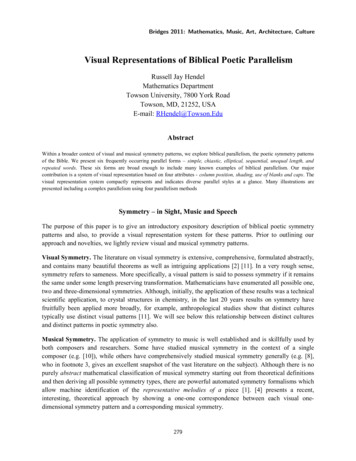
Transcription
Bridges 2011: Mathematics, Music, Art, Architecture, CultureVisual Representations of Biblical Poetic ParallelismRussell Jay HendelMathematics DepartmentTowson University, 7800 York RoadTowson, MD, 21252, USAE-mail: RHendel@Towson.EduAbstractWithin a broader context of visual and musical symmetry patterns, we explore biblical parallelism, the poetic symmetry patternsof the Bible. We present six frequently occurring parallel forms – simple, chiastic, elliptical, sequential, unequal length, andrepeated words. These six forms are broad enough to include many known examples of biblical parallelism. Our majorcontribution is a system of visual representation based on four attributes - column position, shading, use of blanks and caps. Thevisual representation system compactly represents and indicates diverse parallel styles at a glance. Many illustrations arepresented including a complex parallelism using four parallelism methodsSymmetry – in Sight, Music and SpeechThe purpose of this paper is to give an introductory expository description of biblical poetic symmetrypatterns and also, to provide a visual representation system for these patterns. Prior to outlining ourapproach and novelties, we lightly review visual and musical symmetry patterns.Visual Symmetry. The literature on visual symmetry is extensive, comprehensive, formulated abstractly,and contains many beautiful theorems as well as intriguing applications [2] [11]. In a very rough sense,symmetry refers to sameness. More specifically, a visual pattern is said to possess symmetry if it remainsthe same under some length preserving transformation. Mathematicians have enumerated all possible one,two and three-dimensional symmetries. Although, initially, the application of these results was a technicalscientific application, to crystal structures in chemistry, in the last 20 years results on symmetry havefruitfully been applied more broadly, for example, anthropological studies show that distinct culturestypically use distinct visual patterns [11]. We will see below this relationship between distinct culturesand distinct patterns in poetic symmetry also.Musical Symmetry. The application of symmetry to music is well established and is skillfully used byboth composers and researchers. Some have studied musical symmetry in the context of a singlecomposer (e.g. [10]), while others have comprehensively studied musical symmetry generally (e.g. [8],who in footnote 3, gives an excellent snapshot of the vast literature on the subject). Although there is nopurely abstract mathematical classification of musical symmetry starting out from theoretical definitionsand then deriving all possible symmetry types, there are powerful automated symmetry formalisms whichallow machine identification of the representative melodies of a piece [1]. [4] presents a recent,interesting, theoretical approach by showing a one-one correspondence between each visual onedimensional symmetry pattern and a corresponding musical symmetry.279
HendelPoetic Symmetry. Although visual symmetry is the most abstractly developed of all mathematicalsymmetries, poetic symmetry is the oldest. Each culture has developed a unique approach to symmetryand rhetoric. [9] studies Hebrew rhetoric and symmetry. The general intertwining of rhetoric and poetry isvast and we only lightly illustrate it in this subsection. Greek poetry is characterized by the presence ofmeter and rhyme. By contrast, biblical poetry is characterized by the presence of parallel structure [7].Parallel structure simply means that the half-verses of the verse basically express the same idea withdifferent words. Here we see the main ingredients of symmetry: sameness in difference. In the visual area,the difference was accomplished by a transformation which nevertheless left the pattern the same. In thepoetic area, difference is accomplished by different words which nevertheless leave the idea the same.Parallelism as a marker of poetry also occurs in Chinese, Japanese, Finnish, Old Turkish, Mongolian,Rumanian, Sanskrit, and Ugaritic poetry. Even among these different cultures parallel style is developeddifferently. For example, Ugaritic parallelism is characterized by three-clause (vs. the biblical two-clause)phrases, word repetitions and use of complementary word stock pairs (we illustrate this below) [7, pp 2327]. We should also mention the additional intricacy that the musical nature of the poetry, such as thePsalms which were sung, affects the parallel form used – for example [7, pp 109-127] a responsiveantiphonal singing naturally motivates a two vs. a three-clause parallelism.Figure 1 illustrates this idea of sameness of idea with different words. It is reasonable that God and MyLord are different words for the same thing. Similarly, praise and sing while technically differentconcepts both refer to a positive emotional perspective. Finally, in my life and while I continue are bothadverbial phrases indicating a long time. To highlight the idea of parallel repetition, note that the Psalmistcould have communicated his idea with only one half-verse. By using the parallel form, which is thecharacterizing trait of biblical poetry, the Psalmist poet engages in creation of symmetry patterns.Source: Psalm 146:2Subject-VerbObject/Indirect Object Adverbial PhraseHalf-Verse #1I'll praiseGodin my lifeHalf-Verse #1I'll singto my Lordwhile I continue.Figure 1: Parallel representation of verse, Psalm 146:2, “I’ll praise God in my life, I’ll sing to my Lordwhile I continue” [7, pg. 3].Throughout the paper we use the term half-verse to refer to the parallel components of verses eventhough technically there might be three or more half-verses [7, p. 2]. The Figure 1 table is read left toright and top to bottom. The meanings of the column and row headings are obvious. We follow traditionalgrammar in classifying an adverbial prepositional phrase answering the questions to whom or for whom asan indirect object. The table format with its column and row headings and shadings illustrates a visualrepresentation of the verse parallel structure. Most of the features of this visual representation should beobvious. They will be fully explained in the last two sections of the paper.Since this paper is introductory we have not gone into further depth on the relation between rhetoricand symmetry in biblical poetry. We should however at least mention Kugel’s deep thesis on biblicalsymmetry and rhetoric: parallel half-verses are not intended by the author as exactly identical but ratherhave both a retrospective and prospective quality with respect to each other: The second half verse oftenparticularizes, defines or expands the meaning of the first half-verse (prospective) and yet it also mustharken back to the first half-verse in an obvious way to connect it [7, pg. 8].This important idea is illustrated in Figure 1. Lord expands on the term God since Lord emphasizes the280
Visual Representations of Biblical Poetic ParallelismGod-man relationship (prospective); clearly, however, Lord and God refer to the same concept(retrospective and commonality). Similarly, sing expands on the term praise because the praise iscommunicated by music as well as by words (prospective); clearly however sing and praise both indicatea positive emotional perspective (retrospective and commonality) [9, pp. 97-111].Paper Outline. We can now outline the rest of this paper. The varieties of parallel poetic structure appearendless. [7, pg. 15]. Hastings [5] and Geller [3] list a variety of intricate symmetries and attempt tocomplete a comprehensive scheme. In the next section we present six techniques. These six techniqueswere selected because of their frequency of occurrence, because of their simplicity, and because they canbe combined to describe more complex parallel forms, a point illustrated in the final section of the paper.The section of the paper following the description of these six forms contains our main novelty, a methodof visually representing biblical poetic parallel form. Although throughout the paper we exclusively useexamples from the Psalms, our results apply to any biblical book. The Psalms were selected because oftheir primarily poetic nature, their multiple authorships, the multiple periods they span, as well as the richliterature on their parallel form.Six Frequent Biblical Poetic Symmetry FormsRepetition. Since symmetry is defined as sameness in repetition, it follows that repeated words are themost obvious type of symmetry. As example is presented in Figure 2. The repeated word secretly createsa pattern symmetry. Repetition is a frequently used biblical parallel device. A famous example is Psalm136 which contains 26 verses with the second half of each verse containing the repeated phrase for hisgrace is forever. This magnificent Psalm is partially illustrated in Figure 3.Source:AdverbVerbIndirect ObjectObjectPsalm 35:7Half-Verse #1For SECRETLYthey hidefor metheir death-trapHalf-Verse #2SECRETLYthey digfor my soulFigure 2: Parallel structure of verse Psalm 35:7, illustrating the technique of word repetition [7, pg. 5]It is natural to inquire what interpretive affects each particular symmetry form indicates. Most suchassociations are conjectural (and will therefore not be further pursued in this paper). The classicalsymmetry classification works, [3],[5],[7], generally study the form of parallelism without providingcorresponding interpretive affects. This seems to be a rich but open problem.Simple parallelism. We have already seen an example of simple parallelism in Figure 1 in Section 1.Another example is presented in Figure 4. Simple parallelism means that both half-verses have the samenumber and sequence of grammatical functions with each grammatical function met by one or two words.Sequential Parallelism. Sequential parallelism refers to half-verses which present a sequence ofcomponent actions. Sequential parallelism is used when no particular component stands out dramaticallybut rather, each component has independent dramatic significance. An example is presented in Figure 5.Notice how each component action is equally dramatic and important: a) it is dramatic that God saves thevine (the Jewish people) from Egypt, and it is equally dramatic that b) while in the wilderness Godbanished attacking nations from the Jews and it is equally dramatic that c) God enabled settlement of theJews in Canaan despite the presence of powerful military powers and nations.281
HendelSource:Psalm 136Verse 1Half Verse #1, Half VerseWord #1Word #2[Give] Thanksto God#1, Half Verse #1, Half Verse #2Word #3FOR HIS GRACEfor [He is] goodVerse 5Who makesthe heavensVerse 16Who leadsHis nationwithunderstandingin the desertVerse 25Who givesbread [food]to all fleshIS FOREVERFOR HIS GRACEIS FOREVERFOR HIS GRACEIS FOREVERFOR HIS GRACEIS FOREVERFigure 3: Selected verses from Psalm 136 illustration repetition parallelism. Note that biblical Hebrewuses one word (or one hyphenated word) for each cell in half-verse #1 (while English may use morewords).Source:AppositiveNounAdjectivePsalm 135:13Half-Verse #1GodYour nameis foreverHalf-Verse #2GodYour memoryis in each generation.Figure 4: Simple parallel form of verse, Psalm 135:13. Note especially the use of “stock pairs” –name/memory and forever/each generation – characteristic of simple parallelism [7, pg. 6, 27-40].Source: Psalm 80:9Half-Verse #1A-vinefrom-Egyptyou-carriedHalf-Verse #2You-banishednationsHalf-Verse #3You-planted-itFigure 5: Sequential parallel form of verse Psalm 80:9. Further elaboration is found in the article. Thehyphenations of “from-Egypt”, “You-carried”, “you-banished” and “you-planted” reflect that BiblicalHebrew uses one word for these phrases (English however uses several words) [7, pg. 4].Ellipsis. Elliptical parallelism refers to parallel half-verses where one half-verse omits the word(s)corresponding to specific grammatical functions which in turn are elliptically transferred from anotherhalf-verse. A simple example is presented in Figure 6. The second half-verse should really say Godharken to the words of my mouth. However, the word God is absent in the second half-verse and must betransferred from the first half-verse.A more sophisticated example is presented in Figure 7 where each half-verse contains an ellipsis. Thesecond half-verse omits whom they spoke against while the first half-verse omits the citation. We see herea further affect of ellipsis: By forcing the listener to participate and fill in omissions, the listeneracknowledges a possibly unpleasant fact: The Jews were ungrateful and spoke against God.Source: Psalm 54:4Half-Verse #1Half-Verse #2SubjectGodVerbhearharkenObjectmy prayersto the words of mymouthFigure 6: Elliptical parallel structure. Note the omission of the subject in half-verse #2 [7, pg 5].282
Visual Representations of Biblical Poetic ParallelismSource: Psalm 78:19VerbAdverbial PhraseHalf-Verse #1They-Spokeagainst-GodHalf-Verse #2They-saidCitationcan God spread a tablein the desertFigure 7: Verse Psalm 78:19 illustrating elliptical parallelism with complementary omissions [7, pg. 4].Unequal-Length Parallelism. Figure 8 gives a typical example. Each of the two units in the first halfverse is one Hebrew word in length while the single unit in the second half-verse is five Hebrew words.The unequal length can be either in the number of words per unit (1 vs. 5) or the number of units per halfverse (1 vs. 2).Source: Psalm 80:5SubjectAppositiveHalf-Verse #1GodLord of HostsCitationHalf-Verse #2How long will you ignore the prayers of your nationFigure 8: Verse, Psalm 80:5, illustrating unequal length parallelism using a citation [7, pg. 4].The term unequal length parallelism is our own and not standard. However, it unifies various forms ofparallelism such as mere comma (Figure 9), citation (Figure 8), subordination (that is, subordinateclauses), blessing (Figure 10), or a second half-verse appositive to one component of the first half-verse.These examples have in common that either the number of units and/or the number of words per unit inthe two half-verses is blatantly unequal.Source: Psalm 31:25SubjectVerbObjectHalf-Verse #1Strengthen and firmyour heartsHalf-Verse #2All who hope for GodFigure 9: Verse, Psalm 31:25, illustrating unequal length parallelism using mere comma [7, pg. 4].Source: Psalm 28:6Half-Verse #1Half-Verse #2AdjectiveBlessedSubjectbe GodClause-VerbClause-Objectbecause He has the voice of myheardsupplicationFigure 10: Verse, Psalm 28:6, illustrating unequal length parallelism, using a blessing [7, pg. 6].Chiastic parallelism. Chiastic parallelism resembles simple parallelism: two half-verses repeat the sameidea using different words. However, in chiastic parallelism, unlike in simple parallelism, the sequence ofgrammatical functions of the two half-verses is different. Figure 11 presents a typical example.Visual Representation of ParallelismIn this section, we summarize the principles for the visual representations of the various parallel formsillustrated in Figures 1-11 of the previous sections. Three structural assumptions govern these283
Hendelrepresentations:1)-The vehicle of representation is the table2)-Each half-verse receives a distinct (labeled) row3)-Each distinct grammatical unit – subject, verb, direct object, indirect object, adverbial or adjectivalphrases – receives a distinct column.Four attributes are used to represent different parallel styles.1)-Column positions2)-Black and white shading (color enhances visualization but is sometimes not available)3)-Caps4)-Blank words, Blank shading.Table 1 summarizes the visualization methods for six parallel forms presented in this paper and crossreferences illustrative examples from earlier sections.Source:Psalm 29:11Half-Verse #1Half-Verse #2SubjectDirect ObjectAdverbial phraseVerbGodstrengthto His NATIONHe-givesGodblesseshis NATIONwith peace.SubjectVerbObjectAdverbial phraseFigure 11: The Psalmist uses chiasmus, different word-sequence orders, for the two grammaticallyparallel sentences, (#1) “God (subject) gives (verb) strength (direct object) to his nation (adverbialphrase)”, and (#2) “God (subject) blesses (verb) his-nation (direct object) with peace (adverbialphrase)”. Grammatical functions of the two half-verses are indicated on the top and bottom rows.A Complex Parallel ExampleIn this, the final section of the paper, we illustrate a complex parallelism using four parallel techniques.The example is summarized in Figure 12. Note the compact powerful presentation of diverse techniquesareillustrated:1) -Repetition. Each half-verse opens with the repeated word phrase for how long?2)-Ellipsis. The subject of half-verses #1,#2 is God, of half-verses #3,4 is myself, and of half-verse #5 isthe enemy. The verb will-I-place in the verb-object-indirect-object columns in half-verses #3 and #4 alsoillustrates ellipsis. The subject column of half-verse #2 is shaded and blank to indicate the ellipticalrepetition of God. Similarly, the verb column of half-verse #4 is shaded to indicate the elliptical repetitionof will I place. Note that cells not indicating ellipsis are shaded blank.3)-Simple parallelism. The verb-object-indirect object columns of half-verses #2 and #3 illustrate simpleparallelism.4)-Sequential parallelism. This is conjectural but the five verbs possibly illustrate dynamic sequence:i) God (accidentally) forgets meii) Then He willfully hides his face, and as a consequenceiii) I try and counsel myself (that this is temporary), only to find out thativ) I have perpetual anguish that eventually materializes inv) my real dread, the triumph of my enemies.284
Visual Representations of Biblical Poetic ParallelismSourceRepeated Word SubjectPsalm 13:1- (Adverbial2Phrase)Half-Verse #1FOR HOW LONGGodHalf-Verse #2Half-Verse #3FOR HOW LONGFOR HOW LONGHalf-Verse #4Half-Verse #5FOR HOW LONGVerbWill you forget meWill you hideWill I placeObjectAdverbialPhraseYour faceSelfadviceanguishFrom meIn my soulTemporalAdverbForeverIn my heart DailyWilltriumphOver memyenemyFigure 12: A complex parallel example, Psalm 13:1-2, simultaneously using four parallel methods.Parallel TechniqueSimple parallelismChiastic Parallelism Repetition SequentialParallelism Visualization MethodOne grammatical unit per columnWords with identical grammatical functions are aligned.One distinct shading per columnOne grammatical unit per columnOne distinct shading per columnWords in one column may have dissimilar grammaticalfunctions butWords with similar grammatical functions have identicalshadingsTwo column labels may be used for each half-verseUpper case is used to indicate repeated wordsExampleFigures #1,4Figure #11Figures#2,3,11Figure #5One action per rowWords with distinct grammatical functions receive distinctcolumns and shading but Words in the same column need not have distinct identicalfunction Identical shadings are used for identical grammaticalfunctionsUnequal lengthFigures One grammatical unit per column#8,9,10 Distinct shadings are assigned for each grammatical unit The cells for non-parallel grammatical functions are leftblank and unshadedEllipsisFigure #6,7 One grammatical unit per column Distinct shadings are assigned to each grammatical unit Grammatical units not paralleled are left blank but shaded(to indicate the ellipsis)Table 1: Table 1 summarizes the six parallel styles presented in this paper, the principles of visualrepresentation governing them as well as cross-references to illustrative examples.285
HendelReferences[1] K. Adiloglu, T. Noll and K. Obermayer, A Paradigmatic Approach to Extract the Melodic Structureof a Musical Piece, Journal of New Music Research, Vol. 35.3, pp. 221-236, 2006.[2] S. Garfunkle, Project director for COMAP, For all Practical Purposes; Introduction toContemporary Mathematics, 2nd edition, Arlington, Ma: W. H. Freeman and Company, 1991.[3] S. Geller, Parallelism in Early Biblical Poetry, Harvard Semitic Monographs 20, Chico. Ca., 1979.[4] V. Hart, Symmetry and Transformations in the Musical Plane, in Bridges Banff, Mathematics, Music,Art, Architecture, Culture, C. Kaplan and R. Sarhangi, Editors, Tarquin Books, pp. 169-176, 2009.[5] J. Hastings (ed.), Dictionary of the Bible, New York ,1902.[6] R. J. Hendel, Pedagogical Principles for Teaching Art in Mathematics Courses, in Renaissance Banff,Mathematics, Music, Art, Culture: Conference Proceedings, R. Reza Sarhangi and Robert Moody, CentralPlain Book Manufacturing, Winfield, Kansas, pp. 119-120, 2005.[7] J. Kugel, The Idea of Biblical Poetry: Parallelism and Its History, Yale University Press, 1981.[8] R. P. Morgan, Symmetrical Form and Common-Practice Tonality, Music Theory Spectrum, Vol. 20.1,pp. 1-47, 1998.[9] J. Muilenberg, Hebrew Rhetoric: Repetition and Style, Supplements to Vetus Testamentum, 1 Leiden,1953[10] S. Peles, Ist Alles Eins: Schoenberg and Symmetry, Theory Spectrum, Vol. 26.1, pp. 57-86, 2004.[11] D. K. Washburn and D. W. Crowe, Symmetries of Culture: Theory and Practice of Plane PatternAnalysis, Seattle, Washington: University of Washington Press, 1988.286
Towson University, 7800 York Road Towson, MD, 21252, USA E-mail: RHendel@Towson.Edu Abstract Within a broader context of visual and musical symmetry patterns, we explore biblical parallelism, the poetic symmetry patterns of the Bible. We present six frequently occurring parallel forms - simple, chiastic, elliptical, sequential, unequal length .


